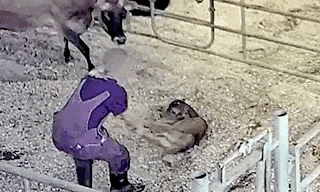In Canadian grocery stores, shoppers are used to seeing products labelled with “Dairy Farmers of Canada Quality Milk.” Yes, the milk comes from cows kept at Canadian dairy farms, but how is the milk actually produced? The truth isn’t always easy to come by. The dairy industry is notorious for misleading advertising that portrays an idyllic life for dairy cows. But in reality, the vast majority of dairy cows endure heartbreaking suffering in factory farms and slaughterhouses.
Factory farms are industrial operations that prioritize profits over animal well-being. Cows are not simply milk-making machines; just like humans, they must become pregnant to produce milk. But how does this work in an industry aiming to make dairy products as quickly and as cheaply as possible?
The dairy industry manipulates nature at every step, and exploits the reproductive systems of cows. This is done by extracting semen from bulls, artificially inseminating mother cows, and then taking their babies away so the mother cow’s milk can be sold for human consumption. When cows’ bodies give out and milk production declines, they are killed and sold for meat.
This is the real journey behind the so-called “quality milk” promoted by Dairy Farmers of Canada, and there’s nothing kind or natural about it.
To extract semen from bulls, the animals are aroused by using a “teaser” animal or an artificial vagina that is warmed and lubricated. The bull is led to mount either the teaser animal or a dummy, and the artificial vagina is positioned to collect the ejaculate.
If the bull doesn’t ejaculate, he endures a process called electro-ejaculation, where a probe is inserted into the bull’s rectum, delivering an electrical current that forces him to ejaculate. This disturbing procedure can cause pain and distress for bulls.
Dairy Cows Are Forcefully Impregnated
To become pregnant, cows must go into heat, also known as estrus, which allows them to be fertile for a period of time.
There are two common methods to inseminate a cow during this period. The first method involves using an instrument called a speculum to open up the vagina. Then, a long thin insemination gun, preloaded with a straw of thawed semen, is shoved into the cow’s vagina, past the cervix, and into the uterus, where the semen is lodged.
It’s also common for farmers to shove their entire arm into the rectum of the cow, an alternative to using a speculum. Farmers feel through the rectal wall to guide the gun, and may manipulate and force the cervix to align it with the opening of the vagina.
During this process, cows are restrained to prevent them from getting away. It’s common for cows to show visible discomfort and distress during insemination. To make matters worse, workers are not always properly trained or experienced, which can cause additional pain and injury to the cows.
If a cow does not become pregnant, she’ll likely endure this cruel procedure again during her next heat cycle.



Baby Cows Taken Away Forever
When baby cows are born, they aren’t allowed to stay with their mothers. To maximize profits, farmers permanently take away calves from mother cows shortly after birth, often within the first 24 hours. Tearing mother cows and babies apart causes severe distress to both of the animals.
If the calf is male, he’ll often be forced into a tiny crate where they will stay until he’s sold and killed for veal, at only a few months old. Female calves are destined to endure the same cycle of forced impregnation and heartbreak as their mothers. Calves who aren’t used for veal or dairy are usually shot shortly after birth.
Mother cows meet a similar fate. At a fraction of her natural lifespan, a cow’s milk production declines, and she is sent to slaughter and killed for hamburger meat. Cows who are forced to give birth over and over again often develop serious health issues before they die, like lameness and mastitis.


Footage from Animal Justice exposé at an organic dairy farm in British Columbia.
Go Dairy-Free
In today’s world, there are plenty of plant-based dairy alternatives that are nutritious, delicious, and cruelty-free. Plant-based milk can be made from oats, soy, coconut, cashews, almonds, and more. By opting for plant-based products, you can stop financially supporting dairy cruelty and make a kinder choice for animals.
Banner: Jo-Anne McArthur | We Animals Media
